The global gable top aseptic cartons market is projected to grow from USD 4 billion in 2025 to approximately USD 6.5 billion by 2035, recording an absolute increase of USD 2,530.3 million over the forecast period. This translates into a total growth of 62.9%, with the market forecast to expand at a compound annual growth rate (CAGR) of 5% between 2025 and 2035. The overall market size is expected to grow by 1.6X during the same period, supported by accelerating demand for food safety and shelf-life extension solutions in liquid food packaging, significant advancements in barrier coating technologies, and expanding adoption of lightweight packaging systems across dairy manufacturers and beverage producers.
The steady market expansion reflects the transformative potential of gable top aseptic packaging technology in revolutionizing liquid food preservation and distribution efficiency. Major food and beverage manufacturers worldwide are increasingly incorporating advanced aseptic carton solutions to enhance product safety and reduce packaging weight through sterilized packaging environments, while breakthrough developments in aluminum-free barrier systems and bio-based coating technologies are creating unprecedented demand for specialized carton configurations that deliver superior preservation performance and environmental compatibility under diverse storage conditions.
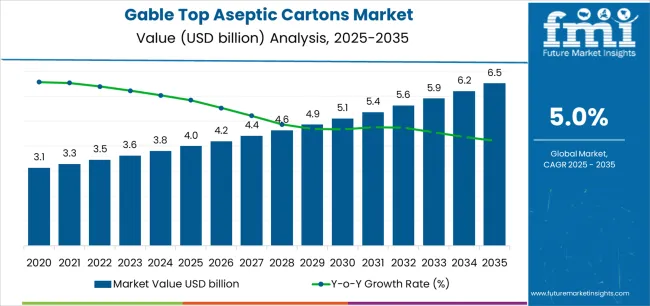
Manufacturing capabilities are advancing rapidly as leading packaging providers invest in precision forming equipment and proprietary barrier coating formulations to meet growing market demand for enhanced shelf stability and reduced material consumption. The technology landscape continues evolving with innovations in heat-sealing architectures, microbiological validation systems, and automated filling technologies that enhance packaging efficiency while reducing contamination risks. Food packaging manufacturers and material specialists are collaborating extensively to develop next-generation aseptic carton products that address specific application requirements across dairy processing, juice manufacturing, and specialty beverage production.
Quality standards are becoming increasingly stringent as applications demand higher barrier properties and greater reliability under extended storage periods including temperature fluctuations, humidity exposure, and transportation stresses. Industry certification programs and validation protocols ensure consistent product performance while supporting market confidence in aseptic carton technology adoption across critical food safety applications and regulated processing environments. Regulatory compliance requirements for food contact materials and packaging sterilization are driving investments in comprehensive quality management systems and testing protocols throughout the manufacturing supply chain.
International collaboration is accelerating market development as major food processing projects require coordinated efforts between multiple packaging suppliers and equipment manufacturers. Global food companies are establishing standardized specifications for aseptic carton performance that influence worldwide packaging standards and create opportunities for specialized material suppliers. Food engineering firms are forming strategic partnerships with packaging technology developers to create application-specific solutions tailored to emerging processing requirements and product preservation needs.
Investment patterns are shifting toward integrated solution development as major food manufacturers seek comprehensive aseptic packaging systems that combine barrier protection capabilities with advanced filling integration and supply chain optimization features. Food companies are forming joint ventures with packaging providers to develop customized carton platforms, while beverage manufacturers are acquiring stakes in specialized packaging technology companies to ensure access to cutting-edge barrier materials for their production and distribution programs. This trend toward strategic partnerships and technology integration is reshaping competitive dynamics across the food packaging value chain.
Market maturation is evident in the emergence of specialized application segments that demand unique barrier characteristics and performance specifications. Premium beverage applications require extremely stable shelf-life performance and aesthetic integration under luxury brand requirements, while industrial food systems need aseptic carton solutions that maintain integrity and efficiency when handling complex processing scenarios and automated packaging integration requirements. These specialized requirements are driving innovation in barrier technologies, forming processes, and integration methodologies that extend beyond traditional dairy and juice packaging applications.
| Metric | Value |
|---|---|
| Market Value (2025) | USD 4 billion |
| Market Forecast Value (2035) | USD 6.5 billion |
| Forecast CAGR (2025-2035) | 5% |
| FOOD SAFETY ADVANCEMENT | BEVERAGE INDUSTRY EXPANSION | ENVIRONMENTAL PACKAGING TRENDS |
|---|---|---|
| Extended Shelf Life: Food preservation technology requiring sophisticated aseptic carton systems for dairy processing, juice manufacturing, and beverage production enabling extended storage periods without refrigeration through sterilized packaging environments and advanced barrier protection with enhanced microbial safety and nutrient retention capabilities. | Ready-to-Drink Markets: Beverage convenience trends implementing integrated aseptic packaging systems requiring precision filling technology for on-the-go consumption, single-serve portions, and retail distribution applications with superior portability and consumer convenience characteristics. | Recyclable Materials: Consumer environmental consciousness driving adoption of aseptic carton systems in food packaging requiring bio-based coating materials for packaging waste reduction, circular economy integration, and enhanced brand positioning with exceptional environmental performance and material recovery capabilities. |
| Food Processing Enhancement: Industrial food manufacturing requiring specialized aseptic packaging technology for contamination prevention, sterile processing integration, and quality maintenance applications with superior microbial control under diverse processing conditions and storage environments. | Functional Beverages: Health-focused beverage categories implementing aseptic carton technology for nutrient preservation, probiotic protection, and functional ingredient stability requiring robust barrier systems and specialized packaging integration. | Lightweight Packaging: Transportation efficiency and cost reduction driving adoption of aseptic carton systems requiring material optimization, structural integrity, and supply chain integration with simplified logistics and reduced carbon footprint characteristics. |
| Regulatory Compliance: Food safety standards requiring enhanced packaging sterilization implementing aseptic carton technology for pathogen elimination, contamination prevention, and regulatory validation with certified performance under food safety testing protocols. | Premium Product Positioning: Brand differentiation and premium market positioning requiring aseptic packaging integration for quality perception, shelf appeal, and consumer confidence with standardized presentation and marketing advantages. | Material Innovation: Packaging technology advancement requiring aseptic carton solutions for barrier enhancement, coating optimization, and processing efficiency with flexible production options and compatibility across multiple food processing platforms. |
| Category | Segments / Values |
|---|---|
| By Type | Standard Aseptic Cartons; Aluminum-free Aseptic Cartons; Bio-based Cartons; Barrier-enhanced Cartons; Others |
| By Application | Dairy Products; Juice Beverages; Plant-based Beverages; Soups & Broths; Others |
| By End-User | Food Manufacturers; Beverage Producers; Co-packers; Private Label Companies; Others |
| By Capacity | 200ml-500ml; 500ml-1000ml; 1000ml and Above; Institutional Packaging |
| By Distribution Channel | Food Manufacturers; Beverage Distributors; Retail Chains; Food Service Providers |
| By Region | North America; Europe; Asia Pacific; Latin America; Middle East & Africa |

| Segment | 2025-2035 Outlook |
|---|---|
| Standard Aseptic Cartons |
|
| Aluminum-free Aseptic Cartons |
|
| Bio-based Cartons |
|
| Others |
|
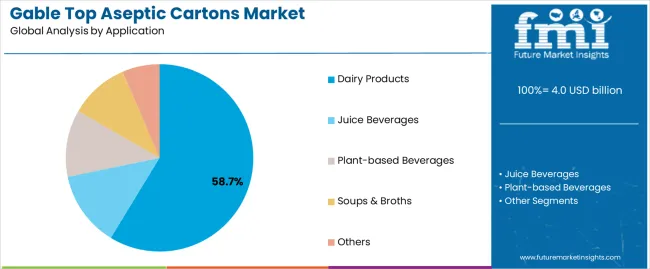
| Segment | 2025-2035 Outlook |
|---|---|
| Dairy Products |
|
| Juice Beverages |
|
| Plant-based Beverages |
|
| Others |
|
| Distribution Channel | Status & Outlook (2025-2035) |
|---|---|
| Food Manufacturers |
|
| Beverage Distributors |
|
| Retail Chains |
|
| Food Service Providers |
|
| DRIVERS | RESTRAINTS | KEY TRENDS |
|---|---|---|
| Food Safety Requirements across liquid food processing and beverage manufacturing creating substantial demand for specialized aseptic packaging devices supporting pathogen elimination, shelf-life extension, and regulatory compliance systems. | High Capital Investment and complex processing equipment requirements limit accessibility across smaller food manufacturers and regional processors with limited packaging automation budgets. | Smart Packaging Integration: Advanced aseptic cartons incorporating intelligent freshness indicators, temperature monitoring capabilities, and consumer interaction features for enhanced food safety communication and brand engagement optimization. |
| Convenience Food Growth: Consumer lifestyle changes and ready-to-drink beverage demand driving adoption of integrated aseptic packaging technology for portability, single-serve applications, and retail distribution convenience. | Material Cost Volatility: Raw material price fluctuations, specialty coating expenses, and barrier technology costs affect production economics and pricing strategies for food manufacturers with budget constraints. | Barrier Technology Enhancement: Innovations in coating systems, material layering, and oxygen transmission reduction delivering enhanced shelf stability, improved product quality, and reduced packaging thickness for food processing applications. |
| Global Food Distribution: International trade expansion and supply chain optimization driving adoption of aseptic packaging systems for extended transportation, climate resilience, and market access applications. | Processing Complexity: Sterilization requirements, equipment integration challenges, and specialized maintenance procedures affect deployment timelines and operational capabilities for food processors lacking dedicated packaging expertise. | Circular Economy Integration: Expanding compatibility with recycling systems, material recovery programs, and waste reduction initiatives creating comprehensive packaging solutions that support environmental goals and regulatory compliance requirements. |
| Shelf-life Extension: Food waste reduction initiatives requiring advanced packaging preservation technology implementing aseptic carton systems for extended storage, distribution flexibility, and inventory management applications. | Regulatory Compliance Costs: Evolving food safety standards and packaging validation requirements create compliance challenges for aseptic packaging adoption affecting market development and technology implementation timelines. | Production Automation: Integration with automated filling systems, quality control technologies, and production line optimization enabling real-time monitoring, efficiency enhancement, and consistent packaging quality for food manufacturing applications. |

| Country | CAGR (2025-2035) |
|---|---|
| China | 6.8% |
| India | 6.3% |
| Germany | 5.8% |
| Brazil | 5.3% |
| United States | 4.8% |
| United Kingdom | 4.3% |
| Japan | 3.8% |
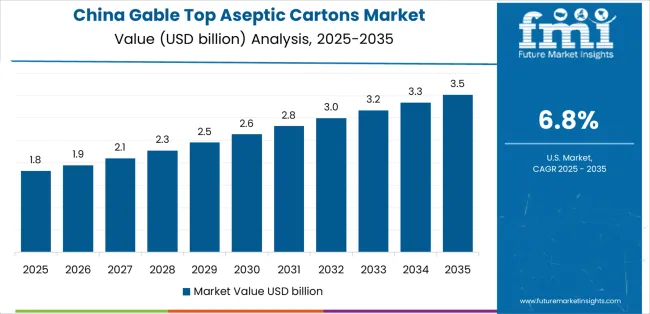
Revenue from Gable Top Aseptic Cartons in China is projected to exhibit exceptional growth with a market value of USD 1.4 million by 2035, driven by massive food processing industry expansion and comprehensive dairy manufacturing development initiatives creating substantial opportunities for aseptic packaging technology suppliers across milk processing, beverage manufacturing, and liquid food production sectors. The country's ambitious food safety enhancement programs including national food quality initiatives and modern packaging infrastructure expansion are creating unprecedented demand for specialized aseptic carton systems. Major food manufacturers and packaging companies including Mengniu, Yili, and local packaging specialists are establishing comprehensive aseptic packaging development programs to support large-scale food production and advanced processing technology applications.
Revenue from Gable Top Aseptic Cartons in India is expanding to reach USD 890.4 million by 2035, supported by extensive dairy industry development programs and comprehensive food processing modernization initiatives creating demand for aseptic packaging solutions across diverse milk processing and beverage manufacturing application segments. The country's growing food processing capabilities and expanding cold chain infrastructure are driving demand for packaging components that provide exceptional shelf stability while supporting advanced food preservation requirements. Food companies and processing facilities are investing in aseptic packaging development to support growing consumer demand and food safety advancement requirements.
Demand for Gable Top Aseptic Cartons in Germany is projected to reach USD 743.6 million by 2035, supported by the country's leadership in food processing technology and advanced packaging systems requiring sophisticated aseptic carton solutions for premium food manufacturing and dairy processing applications. German food operators are implementing cutting-edge packaging platforms that support advanced automation capabilities, operational precision, and comprehensive performance monitoring protocols. The market is characterized by focus on engineering excellence, technology innovation, and compliance with stringent food safety and packaging standards.
Revenue from Gable Top Aseptic Cartons in Brazil is growing to reach USD 612.7 million by 2035, driven by food processing infrastructure development programs and increasing beverage manufacturing capabilities creating opportunities for aseptic packaging suppliers serving both food manufacturers and specialized processing contractors. The country's expanding food sector and growing processing infrastructure are creating demand for packaging components that support diverse food requirements while maintaining performance standards. Food companies and manufacturing facilities are developing packaging strategies to support operational efficiency and system reliability advancement.
Demand for Gable Top Aseptic Cartons in United States is projected to reach USD 523.1 million by 2035, expanding at a CAGR of 4.8%, driven by advanced food processing technology innovation and specialized premium beverage applications supporting organic food manufacturing and comprehensive food technology applications. The country's established food processing tradition including major dairy manufacturers and beverage facilities are creating demand for high-performance aseptic packaging components that support operational advancement and safety standards. Manufacturers and food system suppliers are maintaining comprehensive development capabilities to support diverse food processing and technology requirements.
Revenue from Gable Top Aseptic Cartons in United Kingdom is growing to reach USD 437.2 million by 2035, supported by food processing heritage and established dairy manufacturing communities driving demand for premium aseptic packaging solutions across traditional food systems and specialized processing applications. The country's rich dairy processing heritage including major food manufacturers and established food system capabilities create demand for packaging components that support both legacy system advancement and modern food applications.

Demand for Gable Top Aseptic Cartons in Japan is projected to reach USD 368.9 million by 2035, driven by precision food processing tradition and established manufacturing leadership supporting both domestic food system markets and export-oriented packaging production. Japanese companies maintain sophisticated aseptic packaging development capabilities, with established manufacturers continuing to lead in packaging technology and food processing equipment standards.
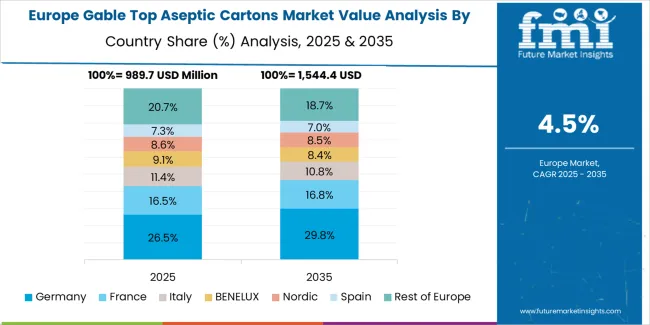
European Gable Top Aseptic Cartons operations are increasingly concentrated between German engineering excellence and specialized manufacturing across multiple countries. German facilities dominate high-performance aseptic packaging production for premium food and dairy processing applications, leveraging cutting-edge manufacturing technologies and strict quality protocols that command price premiums in global markets. British food processing operators maintain leadership in packaging system innovation and aseptic carton method development, with organizations like major dairy cooperatives and university research centers driving technical specifications that suppliers must meet to access major food processing contracts.
Eastern European operations in Czech Republic and Poland are capturing specialized production contracts through precision manufacturing expertise and EU compliance standards, particularly in packaging fabrication and assembly technologies for food applications. These facilities increasingly serve as development partners for Western European food programs while building their own processing technology expertise.
The regulatory environment presents both opportunities and constraints. European food safety framework requirements create quality standards that favor established European manufacturers and food system operators while ensuring consistent performance specifications for critical food infrastructure and safety applications. Brexit has created complexity for UK food collaboration with EU programs, driving opportunities for direct relationships between British operators and international aseptic packaging suppliers.
Technology collaboration accelerates as food manufacturers seek packaging advancement to support major food safety milestones and processing automation timelines. Vertical integration increases, with major food system operators acquiring specialized packaging capabilities to secure component supplies and quality control for critical food programs. Smaller food contractors face pressure to specialize in niche applications or risk displacement by larger, more comprehensive operations serving mainstream food processing and technology requirements.
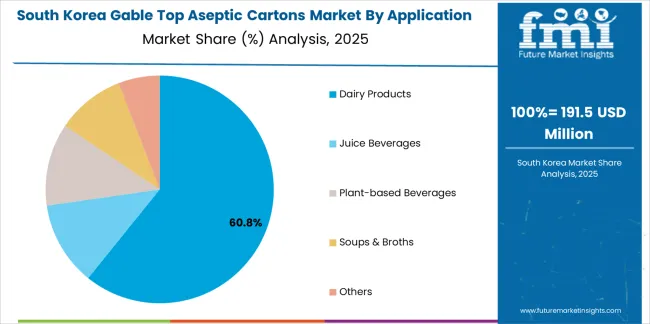
South Korean Gable Top Aseptic Cartons operations reflect the country's advanced food processing technology capabilities and export-oriented packaging development model. Major food system operators including CJ CheilJedang and packaging companies drive component procurement strategies for their processing facilities, establishing direct relationships with specialized aseptic packaging suppliers to secure consistent quality and performance for their food development programs and advanced processing technology systems targeting both domestic infrastructure and international collaboration projects.
The Korean market demonstrates particular strength in integrating aseptic packaging technologies into automated food processing platforms and advanced manufacturing system configurations, with engineering teams developing solutions that bridge traditional food packaging applications and next-generation processing systems. This integration approach creates demand for specific performance specifications that differ from conventional applications, requiring suppliers to adapt packaging capabilities and system coordination characteristics.
Regulatory frameworks emphasize food safety and processing system reliability, with Korean food standards often exceeding international requirements for aseptic packaging systems. This creates barriers for standard packaging suppliers but benefits established manufacturers who can demonstrate food-grade performance capabilities. The regulatory environment particularly favors suppliers with Korean food system qualification and comprehensive testing documentation systems.
Supply chain excellence remains critical given Korea's food processing focus and international collaboration dynamics. Food system operators increasingly pursue development partnerships with suppliers in Japan, Germany, and specialized manufacturers to ensure access to cutting-edge aseptic packaging technologies while managing infrastructure risks. Investment in food processing infrastructure supports performance advancement during extended product development cycles.
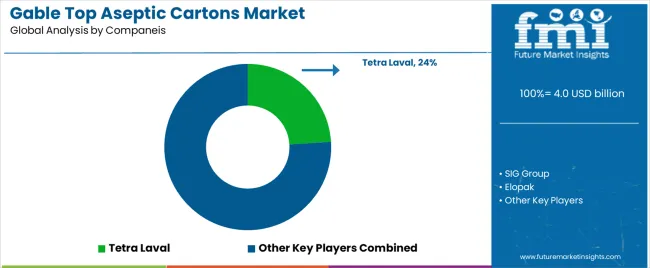
Tetra Laval leads the market with 24% share owing to its integrated packaging solutions and comprehensive aseptic processing systems, which food manufacturers use for dairy processing and beverage production applications. Profit pools are consolidating upstream in advanced barrier technology manufacturing and downstream in application-specific solutions for food processing integration, premium beverage applications, and organic food markets where packaging performance, sterilization capability, and exceptional shelf stability command substantial premiums. Value is migrating from basic carton production to specification-driven, food-grade aseptic systems where barrier expertise, precision manufacturing, and reliable sterilization capabilities create competitive advantages.
Several archetypes define market leadership: established European packaging companies defending share through advanced aseptic technology development and comprehensive food industry integration support; American food packaging suppliers leveraging manufacturing scale and processing system capabilities; Japanese technology leaders with food processing expertise and precision manufacturing heritage; and emerging packaging manufacturers pursuing cost-effective production while developing advanced barrier capabilities.
Switching costs - processing integration, sterilization validation, food safety certification - provide stability for established suppliers, while technology advancement requirements and premium application growth create opportunities for innovative packaging manufacturers. Consolidation continues as companies seek manufacturing scale; direct food manufacturer partnerships grow for specialized applications while traditional packaging distribution remains relationship-driven. Focus areas: secure premium food processing and dairy manufacturer market positions with application-specific performance specifications and technical collaboration; develop aseptic packaging technology and advanced manufacturing capabilities; explore specialized applications including organic food and functional beverage processing requirements.
| Stakeholder Type | Primary Advantage | Repeatable Plays |
|---|---|---|
| European Packaging Leaders | Advanced aseptic technology expertise; proven food processing integration; established manufacturer relationships | Precision manufacturing; technical innovation; food safety certification support |
| American Food Packaging Suppliers | Manufacturing scale; comprehensive food processing programs; established customer partnerships | Engineering collaboration focus; integrated solutions; technical consultation |
| Japanese Technology Leaders | Food processing system expertise; precision technology leadership; trusted by major food programs | Food manufacturer partnerships; application-specific specifications; processing infrastructure collaboration |
| Emerging Packaging Producers | Manufacturing efficiency; competitive pricing; rapid technology development | Production scaling; barrier advancement; market entry strategies |
| Food Distributors | Technical distribution networks; food processing relationships | Food industry expertise; inventory management; technical support services |
| Item | Value |
|---|---|
| Quantitative Units | USD 4 billion |
| Type Segments | Standard Aseptic Cartons; Aluminum-free Aseptic Cartons; Bio-based Cartons; Barrier-enhanced Cartons; Others |
| Applications | Dairy Products; Juice Beverages; Plant-based Beverages; Soups & Broths; Others |
| End-Users | Food Manufacturers; Beverage Producers; Co-packers; Private Label Companies; Others |
| Capacity Segments | 200ml-500ml; 500ml-1000ml; 1000ml and Above; Institutional Packaging |
| Distribution Channels | Food Manufacturers; Beverage Distributors; Retail Chains; Food Service Providers |
| Regions Covered | North America; Latin America; Europe; Asia Pacific; Middle East & Africa |
| Key Countries | China; India; Germany; Brazil; United States; United Kingdom; Japan (+35 additional countries) |
| Key Companies Profiled | Tetra Laval; SIG Group; Elopak; Amcor; Greatview Aseptic Packaging Company; Stora Enso; Nippon Paper Group; International Paper; Ecolearn; Pactiv Evergreen; GsPak; Qingdao Likang Food Packaging Technology; Shandong Newjf Technology Packaging Co., Ltd |
| Additional Attributes | Dollar sales by type and application; Regional demand trends (NA, EU, APAC); Competitive landscape; Food manufacturer vs. beverage producer adoption patterns; Food processing and packaging technology integration; Advanced aseptic innovations driving barrier enhancement, sterilization reliability, and food safety excellence |
The global gable top aseptic cartons market is estimated to be valued at USD 4.0 billion in 2025.
The market size for the gable top aseptic cartons market is projected to reach USD 6.5 billion by 2035.
The gable top aseptic cartons market is expected to grow at a 5.0% CAGR between 2025 and 2035.
The key product types in gable top aseptic cartons market are standard aseptic cartons, aluminum-free aseptic cartons, bio-based cartons, barrier-enhanced cartons and others.
In terms of application, dairy products segment to command 58.7% share in the gable top aseptic cartons market in 2025.






Full Research Suite comprises of:
Market outlook & trends analysis
Interviews & case studies
Strategic recommendations
Vendor profiles & capabilities analysis
5-year forecasts
8 regions and 60+ country-level data splits
Market segment data splits
12 months of continuous data updates
DELIVERED AS:
PDF EXCEL ONLINE
Gable Box Market Trends & Industry Growth Forecast 2024-2034
Gable Top Packaging Machine Market Size and Share Forecast Outlook 2025 to 2035
Gable Top Packaging for Liquid Food Market Size and Share Forecast Outlook 2025 to 2035
Gable Top Packaging Market Size and Share Forecast Outlook 2025 to 2035
Gable Top Caps And Closures Market by Material, Product & Distribution Forecast 2025 to 2035
Competitive Overview of Gable Top Caps And Closures Companies
Gable-Top Liquid Cartons Market Size and Share Forecast Outlook 2025 to 2035
Top Loading Cartoning Machine Market Forecast and Outlook 2025 to 2035
Topical Anti-infective Drugs Market Size and Share Forecast Outlook 2025 to 2035
Topical Antibiotic Pharmaceuticals Market Size and Share Forecast Outlook 2025 to 2035
Top Coated Direct Thermal Printing Films Market Size and Share Forecast Outlook 2025 to 2035
Top Labelling Equipment Market Trends - Growth & Forecast 2025 to 2035
Topical Wound Agents Market Analysis - Trends, Growth & Forecast 2025 to 2035
Topical Drugs Packaging Market Growth & Forecast 2025 to 2035
Topical Bioadhesives Market - Trends & Forecast 2025 to 2035
Competitive Breakdown of Top Coated Direct Thermal Printing Films Providers
Top Bottom Packaging Box Market from 2024 to 2034
Global Topical Pain Relief Market Insights – Size, Trends & Forecast 2024-2034
Topical Applicator Market Growth & Pharmaceutical Innovations 2024-2034
Atopic Dermatitis Treatment Market Analysis Size, Share, and Forecast Outlook 2025 to 2035

Thank you!
You will receive an email from our Business Development Manager. Please be sure to check your SPAM/JUNK folder too.
Chat With
MaRIA